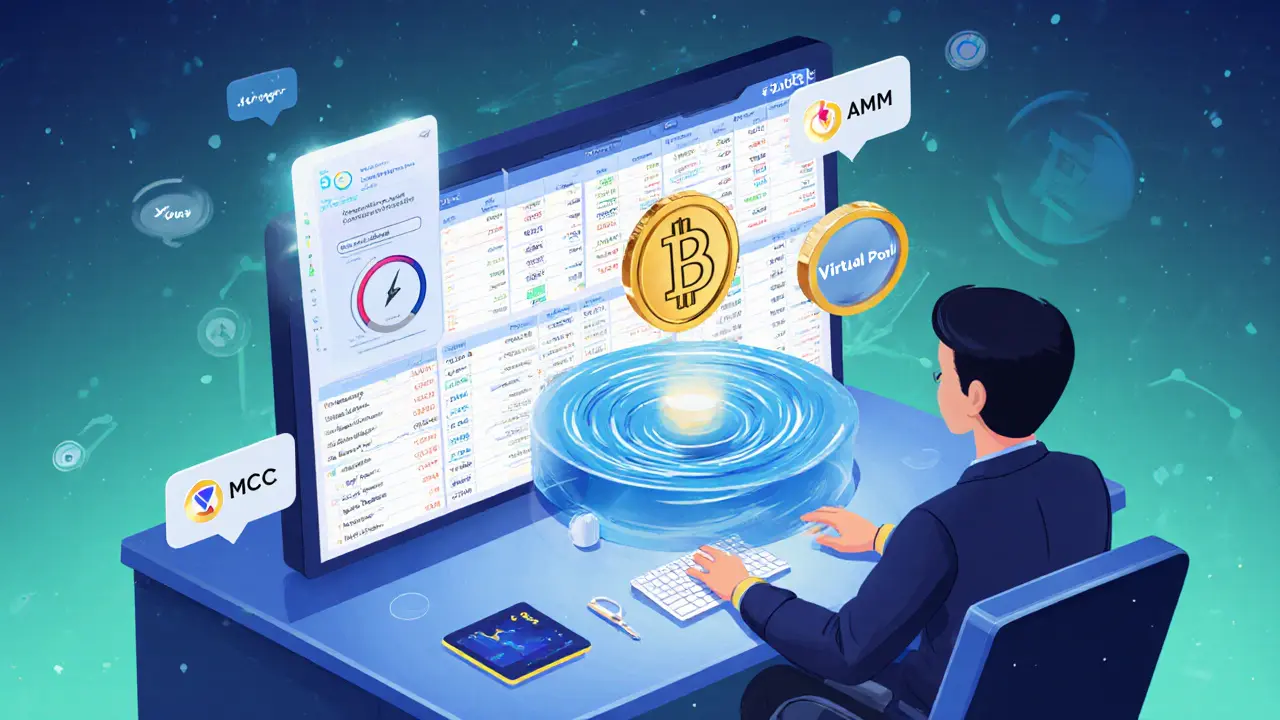
MCB Token Price Forecast Calculator
Current Price: $1.25
Market Cap: $12.5M
24h Change: +3.2%
Risk Level: Moderate
Projected Price: $3.45
Potential Return: $245.00
ROI Percentage: 24.50%
Investment Value: $1,245.00
Investment Risk Factors
- Volatility: MCB token price exhibits extreme fluctuations due to market sentiment and platform adoption.
- Regulatory Uncertainty: Perpetual contracts operate in a regulatory gray area, potentially affecting accessibility.
- Platform Risks: Smart contract vulnerabilities and liquidity constraints can impact token value.
- Market Competition: MCDEX competes with established platforms like dYdX and Uniswap.
Quick Takeaways
- MCDEX is the first fully‑permissionless DEX that focuses exclusively on perpetual contracts.
- It runs on Ethereum, uses a custom AMM for derivatives, and lets anyone create new markets without approval.
- The native governance token, MCB, powers the DAO but its price outlook is highly disputed.
- Wallet integration includes MetaMask, Trust Wallet, WalletConnect and others, keeping user funds non‑custodial.
- Compared with dYdX and Uniswap, MCDEX offers deeper derivatives features but faces liquidity and regulatory challenges.
Here is our MCDEX review, a straightforward look at how the platform works, who it serves, and what risks you should know before trading perpetual contracts on a decentralized exchange.
What is MCDEX?
MCDEX is a permissionless decentralized exchange that enables trading of perpetual contracts on the Ethereum blockchain. Launched in 2020, it introduced a specialized Automated Market Maker (AMM) designed for derivatives rather than spot token swaps. By aggregating liquidity around price indices, MCDEX aims to improve capital efficiency for traders who want leverage without handing over custody to a centralized entity.
How the Platform Works
Unlike traditional DEXs that match token pairs directly, MCDEX’s AMM creates a virtual liquidity pool for each perpetual market. The pool tracks an index price (often derived from multiple oracle feeds) and offers funding rates that keep contract prices tethered to the underlying asset. Traders deposit collateral (usually ETH or stablecoins) into the pool, open leveraged positions, and the smart contract automatically handles liquidation when collateral falls below maintenance thresholds.
Because the system is permission‑less, any user can launch a new perpetual market by calling the contract factory. The factory records the market parameters-underlying asset, funding interval, leverage limits-and publishes the market immediately, subject only to the DAO’s governance vote if the community wishes to enforce additional checks.
Governance and the MCB Token
MCB is the native governance token of the platform. Holders participate in the MCDEX DAO, where proposals are discussed off‑chain (e.g., Discord, forum) and executed on‑chain after a voting quorum is met. The DAO can tweak fee structures, add new oracle integrations, or even upgrade core contracts. While the token’s utility is clear, price forecasts vary dramatically: some analysts see a three‑digit upside by 2030, while others predict a collapse to near zero, reflecting the broader uncertainty around niche DeFi governance tokens.

Connecting Your Wallet
MCDEX is non‑custodial, so you retain full control of private keys. The platform supports major Ethereum‑compatible wallets, including MetaMask, Trust Wallet, WalletConnect and WalletLink. After connecting, you approve a single transaction that grants the MCDEX router permission to move your collateral. No KYC is required, aligning MCDEX with the broader no‑KYC exchange ecosystem.
User Experience and Interface
The front‑end mimics centralized exchanges: a clean order‑book view, real‑time funding rate display, and leverage selector. However, the learning curve is steeper than a typical spot‑trading DEX because users must understand concepts like funding rates, liquidation penalties, and the AMM’s slippage model. Documentation is community‑driven, with DAO‑maintained guides and tutorial videos, but it lacks the polish of larger platforms such as dYdX.
Liquidity and Capital Efficiency
Liquidity is the lifeblood of any derivatives market. MCDEX’s permission‑less design theoretically allows endless market creation, but actual depth depends on traders providing capital to each pool. In Q22025, perpetual contracts accounted for roughly 72% of total crypto‑derivatives volume, yet MCDEX’s share of that volume remains modest compared with dYdX, which hosts dozens of deep markets. The platform mitigates fragmentation by routing trades through a virtual AMM that aggregates small pools, but the effectiveness of this approach still hinges on community participation.
Pros and Cons
- Pros:
- Fully permission‑less market creation expands asset coverage.
- Non‑custodial design protects user funds from exchange hacks.
- Custom AMM reduces slippage for high‑leverage trades.
- DAO governance gives token holders a voice in protocol upgrades.
- Cons:
- Liquidity is uneven; new markets may suffer from shallow depth.
- Complex derivatives concepts increase onboarding friction.
- Regulatory gray area for perpetual contracts could restrict access in some jurisdictions.
- MCB token price forecasts are highly volatile, adding financial risk.
How MCDEX Stacks Up Against Competitors
| Feature | MCDEX | dYdX | Uniswap |
|---|---|---|---|
| Primary market type | Perpetual contracts | Perpetual contracts & spot | Spot token swaps |
| Permission model | Fully permission‑less | Permissioned for new markets | Permissionless spot pairs |
| Governance token | MCB | DYDX | UNI |
| Wallet integration | MetaMask, Trust, WalletConnect, WalletLink | MetaMask, Ledger, WalletConnect | MetaMask, Coinbase Wallet, WalletConnect |
| Leverage options | Up to 20× | Up to 25× | None (spot only) |
| KYC requirement | No | No for most features, but some services require KYC | No |

Price Outlook for MCB Token
Analyst forecasts diverge sharply. One model published by WalletInvestor in early 2025 predicts a year‑end price of $3.45, implying a 358% return. Another source, PricePrediction.net, is far more bullish, forecasting $21.09 for 2025 and $147.52 by 2030. Conversely, TradingBeast argues the token could fall to $0 as early as December 2025. The spread reflects two opposing narratives: optimists highlight MCDEX’s innovative permission‑less architecture, while skeptics point to limited liquidity and looming regulatory pressure on derivatives DEXs.
Investors should treat MCB as a high‑risk asset. Its value is tied not only to platform usage but also to DAO participation rates, token burn mechanisms, and broader market sentiment toward DeFi derivatives.
Risks and Regulatory Considerations
Perpetual contracts sit in a regulatory gray zone in many countries. While MCDEX does not require KYC, jurisdictions such as the United States and Canada have begun restricting access to derivatives platforms that serve retail users. Users in those regions may face blocked IPs or forced account closures. Additionally, smart‑contract risk remains: a bug in the AMM logic could trigger unintended liquidations or loss of collateral. Audits have been conducted, but the fast‑moving nature of DeFi means new vulnerabilities can surface.
Liquidity risk is another practical concern. If a market’s pool is shallow, a large trade can cause severe slippage, eroding profit margins. Traders should check pool depth before committing significant capital, and consider spreading exposure across multiple DEXs.
Getting Started: A Step‑by‑Step Guide
- Install a compatible Ethereum wallet (e.g., MetaMask) and fund it with ETH or a stablecoin.
- Navigate to the MCDEX website and click “Connect Wallet”. Approve the connection request.
- Select a perpetual market from the list (e.g., BTC‑USD). Review the current funding rate and leverage limits.
- Deposit collateral into the market’s pool. The transaction will include a small gas fee.
- Choose your leverage, set stop‑loss and take‑profit levels, then confirm the trade.
- Monitor your position. Funding payments or liquidations happen automatically based on the contract’s rules.
Remember to keep a modest amount of ETH aside for gas, especially during network congestion.
Final Thoughts
MCDEX delivers a unique proposition: a truly permission‑less environment for perpetual contracts on Ethereum. For experienced derivatives traders who value non‑custodial control and want to explore niche assets, the platform offers compelling tools. However, the ecosystem is still maturing, liquidity can be thin, and the MCB token’s price trajectory remains wildly speculative. We recommend starting with small positions, diversifying across other DEXs like dYdX, and staying alert to regulatory updates that could affect access.
Frequently Asked Questions
Is MCDEX safe to use?
Safety depends on three factors: the underlying smart‑contract code, the liquidity of the market you trade, and your own security hygiene. MCDEX contracts have been audited, but no code is immune to bugs. Use a hardware wallet if possible and start with low‑risk positions.
How does MCDEX differ from Uniswap?
Uniswap is built for spot token swaps, while MCDEX specializes in perpetual futures. MCDEX uses a custom AMM that tracks an index price and applies funding rates, which Uniswap does not offer.
Can I trade on MCDEX without KYC?
Yes. MCDEX is a non‑custodial DEX, so you only need an Ethereum‑compatible wallet. However, some jurisdictions may block access to derivatives platforms.
What is the role of the MCB token?
MCB is the governance token of the MCDEX DAO. Holders can vote on protocol upgrades, fee changes, and new market proposals. It also provides limited fee‑rebate incentives for liquidity providers.
How do funding rates affect my trade?
Funding rates are periodic payments exchanged between long and short positions to keep the perpetual price aligned with the underlying index. A positive rate means longs pay shorts, and vice‑versa. These payments are settled automatically by the smart contract.


Comments
ചഞ്ചൽ അനസൂയ
Hey folks, just wanted to say MCDEX looks pretty promising for folks who crave non‑custodial derivatives. The permissionless market creation is a neat way to keep the ecosystem fresh. If you’re just starting, try a tiny position and watch the funding rates – they’re the hidden cost you don’t want to miss. Remember, leverage amplifies both gains and losses, so keep your risk management tight. Stay curious and keep learning, you’ll get the hang of it faster than you think.
gayle Smith
Whoa, this review just dropped the curtain on the whole MCDEX saga! The platform’s architecture is like a high‑octane rocket fueled by perpetual contracts, completely bypassing traditional gatekeepers. It’s basically a DeFi paradigm shift, a quantum leap in permissionless finance. Yet, the volatility index screams “high‑risk” louder than a fire alarm in a warehouse. In short, enter at your own peril, but the upside could be spectacular if the DAO nails the governance game.
mark noopa
Alright, let’s unpack this whole MCDEX thing from a philosophical perspective, because every decentralized protocol is basically an experiment in collective consciousness 🤔. First, the notion of a permissionless perpetual contract market challenges the very idea of scarcity; we’re talking about infinite creation of synthetic exposure, which is both liberating and terrifying. Second, the MCB token acts as a dual‑purpose artifact: governance lever and speculative asset, merging power dynamics with pure market sentiment. Third, the AMM model for derivatives isn’t just a technical novelty, it’s a redefinition of liquidity provision, where risk is distributed across a network of lenders rather than a centralized order book. Fourth, the DAO structure embodies a new form of digital deliberative democracy, but only if the community stays engaged and avoids capture by whales. Fifth, the platform’s non‑custodial nature reasserts the cyber‑punk dream of self‑sovereignty, yet it simultaneously introduces smart‑contract risk that could erode trust faster than a flash crash. Sixth, the funding rate mechanism is a clever feedback loop that aligns long and short incentives, but it also adds a hidden layer of cost that can bite unwary traders. Seventh, the regulatory gray area surrounding perpetual contracts creates a legal limbo – it’s like walking on a tightrope over a canyon of potential lawsuits. Eighth, the competition with dYdX and Uniswap forces MCDEX to constantly innovate, which could lead to a rapid feature churn that overwhelms users. Ninth, the tokenomics, including any burn or fee‑rebate schemes, will be crucial in determining long‑term token value, especially under market stress. Tenth, the community‑driven documentation is both a strength and a weakness; while it empowers users, it also leads to inconsistency. Eleventh, the reliance on oracles for price feeds introduces an oracle‑risk vector that could be exploited. Twelfth, the platform’s gas costs on Ethereum can become prohibitive during network congestion, eroding profit margins. Thirteenth, liquidity depth remains the Achilles’ heel; shallow pools can cause slippage that nullifies leveraged gains. Fourteenth, the permissionless market creation democratizes access to niche assets, but could also flood the market with low‑quality contracts. Fifteenth, the overall user experience strives to mimic centralized exchanges, yet the learning curve is steeper, demanding a hybrid of trader savvy and developer mindset. In sum, MCDEX is a bold experiment that pushes the boundaries of decentralized finance, but it’s a high‑stakes game that demands both technical literacy and risk appetite. 🚀
Rama Julianto
Listen, the review glosses over the fact that MCDEX’s liquidity is still a joke in many markets. You can’t just "launch" a new perpetual and expect deep order books; you need serious capital backing. The smart‑contract audits are decent, but any flaw could wipe you out faster than a flash loan attack. Bottom line: tread carefully and bring your own insurance.
Helen Fitzgerald
Great rundown! If you’re feeling the hype, start with a small position and test the funding rates. The community vibe is supportive, and you can learn a lot from the DAO discussions. Keep your gas fees in mind though – they can eat into tiny profits. Happy trading, and remember to stay diversified!
Jon Asher
Totally agree, the low‑fee structure makes it easy for newbies to dip their toes without burning through capital. Plus the non‑custodial setup means you stay in control of your keys.
Scott Hall
Nice overview. I’ve been using MCDEX for a few weeks and the UI feels surprisingly familiar if you’ve used dYdX before. The main thing is to keep an eye on the slippage when you open high‑leverage positions.
Jade Hibbert
Oh wow, look at you, dropping wisdom like it’s hot. Sure, slippage is a thing, but that’s why some of us actually read the docs.
Leynda Jeane Erwin
While the review is thorough, it neglects to address the potential legal ramifications of using perpetual contracts in certain jurisdictions. Moreover, the token’s speculative nature may attract regulatory scrutiny sooner rather than later. Users should consult local regulations before diving in.
Brandon Salemi
Good point – a quick legal check can save you a lot of trouble later.